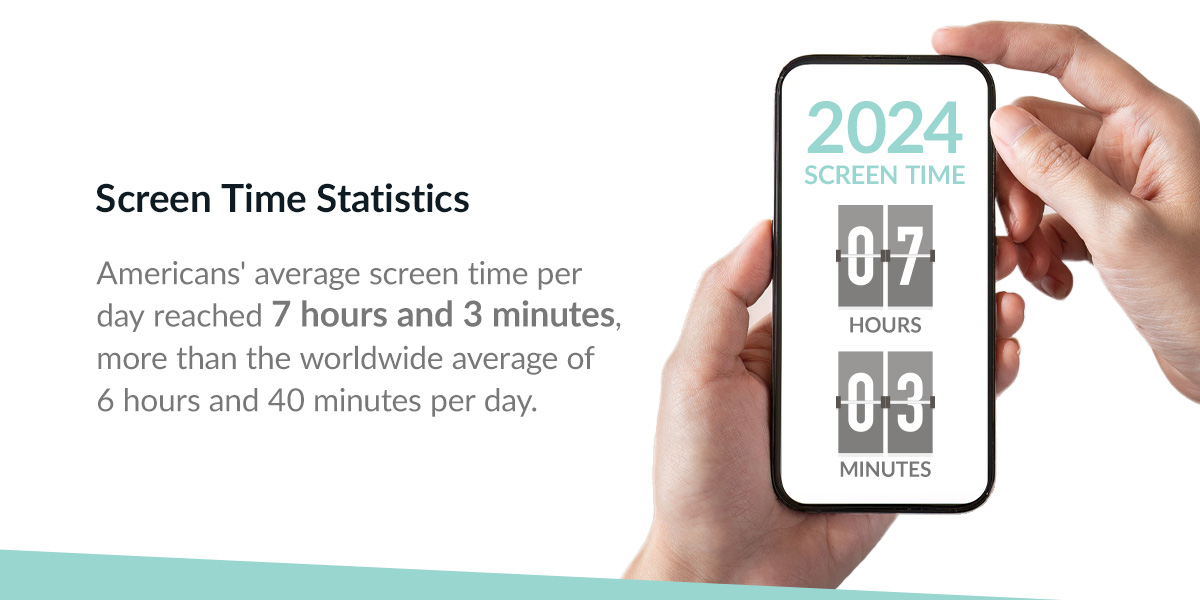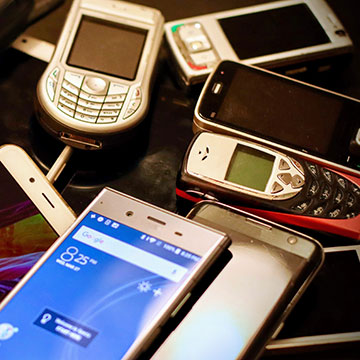
The invention of the smartphone changed screen time and social media use as we know it. In what seemed like an overnight transformation, people could now access whatever they needed in the palm of their hand. Though smartphone and social media use are not the only forms of screen time, they significantly increased during the early days of the COVID-19 pandemic.
According to research, users aged 16 to 64 spend an average of 6 hours and 40 minutes daily on screens across various devices. This is important information, especially for marketers constantly looking for innovative ways to connect with their audience. Below, we explore more important screen time statistics and how you can use them to improve your marketing.
Screen Time Statistics—2020 to Today
How long do most people spend looking at screens daily? Dozens of devices require people to look at a screen—from watching TV to working on a laptop or tablet to finding your way to unfamiliar places with a GPS.
What factors might influence their engagement with brands, services and businesses? We’ve gathered data and analyzed trends from the past five years to understand screen time statistics clearly. This information can help you see trends and make informed decisions.
2020
According to the National Library of Medicine (NLM), young Americans spent an average of 28.5 hours per week (roughly four hours per day) on their phones in 2020. The same year also saw a spike in Internet use, from 50% to 70% in America and a 50% increase in Australia. This was largely due to the pandemic’s influence on remote work and schooling.
The digital marketing space also saw incredible growth. Social media ad revenue reached $41.5 billion, and e-commerce saw a spike in online sales from $570 billion to $815 billion.
2021
The COVID-19 pandemic and some of its ramifications (such as an increase in screen time) continued well into 2021. Research from Standford University found that American consumers checked their smartphones 50 to 80 times per day and spent 2.5 hours on social media alone. During this time, researchers also highlighted that users spent more time consuming online media than they did watching TV.
In 2021, nearly 85% of adults reported using social media, while children and teens had increased screen time compared to the same demographic in 2019. The smartphone penetration rate in Australia saw a steady increase from previous years, reaching 85.7% of the population in 2021.
2022
Research shows that consumers spent an average of 2.5 hours on social media daily, and 83% of users said they discover new products and services on social media. By this point, many businesses had established innovative marketing and communication strategies to take advantage of retail and shopping experiences that existed partially or entirely online.
As of June 2022, almost 50% of millennials reported a positive experience with brands interacting with them via text message marketing, indicating a sustained relationship with digital brand presences.
Social media ad spending in the U.S. also saw incredible growth, reaching $66.7 billion, up by $3.6 billion from the previous year.
2023
During the fourth quarter of 2023, consumers had an average daily screen time of six hours and 35 minutes. In the U.S., teenagers spent an average of 4.8 hours on social media platforms daily. Meanwhile, global retail e-commerce sales reached an estimated $5.8 trillion.
About 30% of business owners and marketing managers claimed younger consumers preferred interacting through text compared to other marketing channels. Another survey revealed that 46% of consumers would opt into text marketing from retailers and e-commerce platforms, and 55% would agree to receive text messages from health providers.
The most popular social media platform in the U.S. in 2023 was TikTok, with adults spending an average of 53.8 minutes daily on it. YouTube was next, with an average of 48.7 minutes per day. These numbers are why TikTok alone generated $165.1 billion in revenue in 2023. For Australia, screen time dropped to 5 hours and 51 minutes on average per day. Social media usage received a significant portion (2 hours and 4 minutes) of this time.
2024
The Pew Research Center reports that 97% of Americans aged 18 to 49 own a smartphone in 2024. Of these adults, at least 15% say they completely depend on their smartphones for internet use.
In 2024, Americans’ average screen time per day reached 7 hours and 3 minutes, more than the worldwide average of 6 hours and 40 minutes per day. Most of this time was spent streaming television shows. Time spent on social media daily averaged about two hours and 14 minutes.
Studies also show that the average person picked up their phone 58 times per day. In Australia, a Deloitte survey shows that 90% of the population possess a smartphone, and a significant proportion used it for social media and messaging apps.
In the younger population, the average screen time by age exceeded the recommended one hour per day for children two to five years old and two hours per day for five to 17-year-olds.
What Do These Screen Time Statistics Tell Us?
Now that we grasp the impact of daily screen time on the average user’s day, what are the next steps? Business visionaries everywhere must do the same thing they have always done to stay ahead—evolve! Digital technology remains a boon to anyone who prefers completing daily tasks from the comfort of their home, including:
- Education
- Shopping
- Working
- Entertaining
- Socializing
- Meeting
Screen time has become an integral part of most people’s daily routines, which presents a unique opportunity for businesses that want to make a positive impact.
Digital marketing is essential to establishing and sustaining customer relationships. Your business may have to switch from traditional methods to digital platforms that directly engage customers, such as short message service marketing.
How to Use SMS to Reach Customers
According to Dr. Dimitri Christakis, director of the Center for Child Health, Behavior and Development at Seattle Children’s Research Institute, increased screen time isn’t necessarily the problem—it’s the content users consume. For instance, activities like focusing on a documentary, participating in an online book club or learning a language are more mentally challenging than hours of mindless scrolling. That presents businesses with an opportunity to transform activities that we perceive as entirely recreational into meaningful, two-way connections between brands and their customers.
As a marketer, your goal is not to increase your customers’ screen time—it’s to communicate to them through their preferred channels. Whether that’s online, through social media or in a brick-and-mortar store, you can use digital solutions to adapt to your customers’ changing needs and expectations. For instance, with business SMS, you can offer:
- Appointment reminders
- Urgent updates
- Flash sales
- Reminders of business hour changes
- Internal communications to employees and colleagues
- Exclusive promotions
- Two-way messaging
- Queued-up, scheduled texts
Experts project SMS marketing will reach over $12 billion by 2025. Additionally, SMS has a better average click-through rate, higher open rate and fewer customer complaints than other marketing tools.
Contact the Experts at CompleteSMS to Reach Your Audience Today
The average screen time continues to increase across the globe. This can be a great opportunity for businesses to connect with their audience on the platforms they already use. SMS marketing can help you communicate with your market in a quick, easy and accessible way.
Our mission at CompleteSMS is to help your business effectively engage with its customers through SMS. Whether you’re looking for bulk, web or Gmail SMS, we have customized solutions to help you create tailored and personalized communication. Request a demo online or contact us to learn more about our solutions!



































































